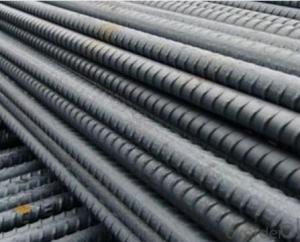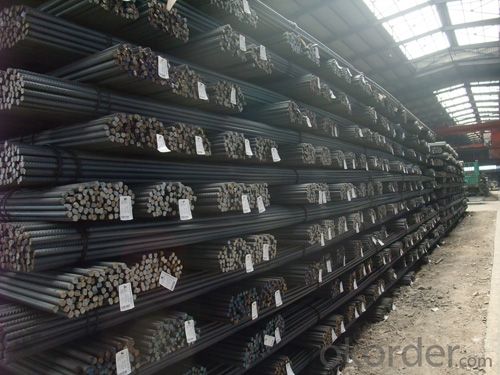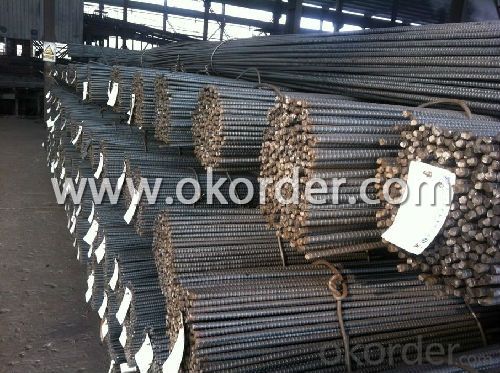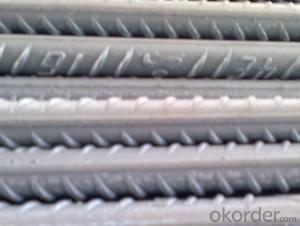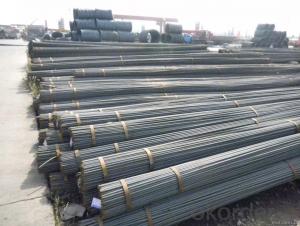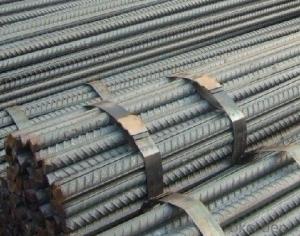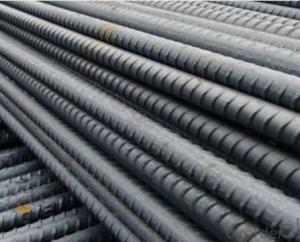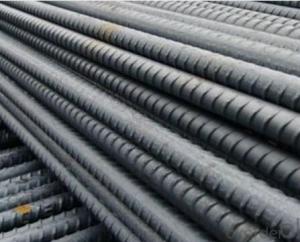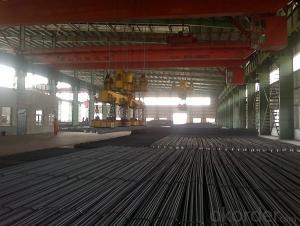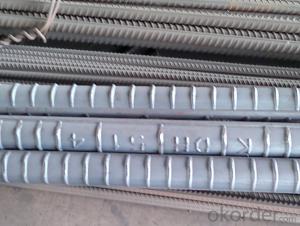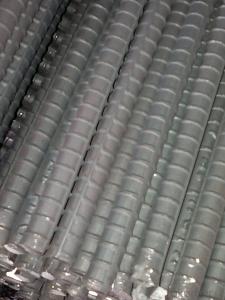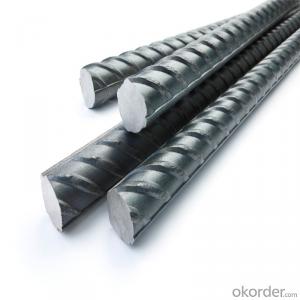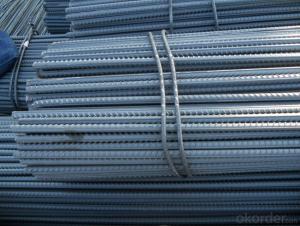Hot Rolled Steel Rebar ASTM Standard
- Loading Port:
- Tianjin
- Payment Terms:
- TT or LC
- Min Order Qty:
- 100 m.t.
- Supply Capability:
- 10000 m.t./month
OKorder Service Pledge
OKorder Financial Service
You Might Also Like
OKorder is offering Hot Rolled Steel Rebar ASTM Standard at great prices with worldwide shipping. Our supplier is a world-class manufacturer of steel, with our products utilized the world over. OKorder annually supplies products to African, South American and Asian markets. We provide quotations within 24 hours of receiving an inquiry and guarantee competitive prices.
Product Applications:
Hot Rolled Steel Rebar ASTM Standard are ideal for structural applications and are widely used in buildings, bridges, roads and other engineering construction. Big to highways, railways, bridges, culverts, tunnels, public facilities such as flood control, dam, small to housing construction, beam, column, wall and the foundation of the plate, deformed bar is an integral structure material..
Product Advantages:
OKorder's Hot Rolled Steel Rebar ASTM Standard are durable, strong, and wide variety of sizes.
Main Product Features:
· Premium quality
· Prompt delivery & seaworthy packing (30 days after receiving deposit)
· Can be recycled and reused
· Mill test certification
· Professional Service
· Competitive pricing
Product Specifications:
Standard | GB UK USA | HRB335 HRB400 HRB500 G460B, B500A, B500B,B500C GR40, GR60 | |
Diameter | 6mm,8mm,10mm,12mm,14mm,16mm,18mm,20mm, 22mm,25mm,28mm,32mm,36mm,40mm,50mm | ||
Length | 6M, 9M,12M or as required | ||
Invoicing | Actual or Theoretical Weight Basis as buyer’s request. | ||
Type | Hot rolled steel rebar | ||
Diameter(mm) | Section area (mm²) | Mass(kg/m) | Weight of 12m (kg) | Pcs/ton |
6 | 28.27 | 0.222 | 2.664 | 375.38 |
8 | 50.27 | 0.395 | 4.74 | 210.97 |
10 | 78.54 | 0.617 | 7.404 | 135.06 |
12 | 113.1 | 0.888 | 10.656 | 93.84 |
14 | 153.9 | 1.21 | 14.52 | 68.87 |
16 | 201.1 | 1.58 | 18.96 | 52.74 |
18 | 254.5 | 2.00 | 24 | 41.67 |
20 | 314.2 | 2.47 | 29.64 | 33.74 |
22 | 380.1 | 2.98 | 35.76 | 27.96 |
25 | 490.9 | 3.85 | 46.2 | 21.65 |
28 | 615.8 | 4.83 | 57.96 | 17.25 |
32 | 804.2 | 6.31 | 75.72 | 13.21 |
36 | 1018 | 7.99 | 98.88 | 10.43 |
40 | 1257 | 9.87 | 118.44 | 8.44 |
50 | 1964 | 15.42 | 185.04 | 5.40 |
FAQ:
Q1: Why buy Materials & Equipment from OKorder.com?
A1: All products offered byOKorder.com are carefully selected from China's most reliable manufacturing enterprises. Through its ISO certifications, OKorder.com adheres to the highest standards and a commitment to supply chain safety and customer satisfaction.
Q2: How do we guarantee the quality of our products?
A2: We have established an advanced quality management system which conducts strict quality tests at every step, from raw materials to the final product. At the same time, we provide extensive follow-up service assurances as required.
Q3: How soon can we receive the product after purchase?
A3: Within three days of placing an order, we will arrange production. The normal sizes with the normal grade can be produced within one month. The specific shipping date is dependent upon international and government factors, the delivery to international main port about 45-60days.
Images:
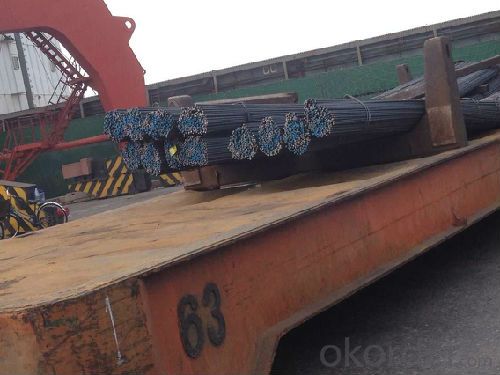
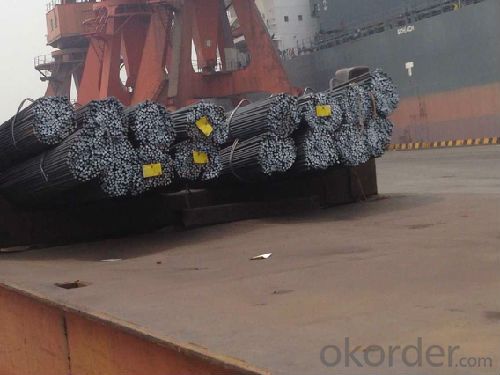
- Q: What are the methods used for corrosion protection of steel rebars?
- There are several methods used for corrosion protection of steel rebars, including the application of protective coatings, cathodic protection, and the use of corrosion inhibitors. Protective coatings, such as epoxy or zinc-based coatings, create a barrier between the rebar and the surrounding environment, preventing corrosion. Cathodic protection involves the use of sacrificial anodes or impressed current to protect the rebar by providing a more reactive surface for corrosion. Corrosion inhibitors are chemicals that are added to the concrete mix or applied directly to the rebar, forming a protective layer and reducing the rate of corrosion.
- Q: What are the different types of steel rebars used in high-rise buildings?
- The different types of steel rebars commonly used in high-rise buildings include carbon steel rebars, epoxy-coated rebars, stainless steel rebars, and galvanized rebars. These rebars have varying properties and are chosen based on factors like strength, corrosion resistance, and durability to ensure structural integrity and safety in the building's construction.
- Q: What are the different types of steel rebars used in earthquake-prone regions?
- Various types of steel rebars are utilized in earthquake-prone regions to bolster the structural integrity and resilience of buildings. These rebars are specifically engineered to withstand the formidable forces generated during seismic events, thereby mitigating the risk of structural failure. The commonly employed steel rebars in earthquake-prone regions encompass the following: 1. Mild Steel Rebars (MSR): Also known as carbon steel rebars, MSR rebars are the most frequently utilized due to their affordability and widespread availability. They possess a relatively low yield strength, typically ranging from 250 to 420 megapascals (MPa). While they provide basic reinforcement, they are not specifically designed to endure intense seismic forces. 2. High-Strength Deformed Bars (HSD): HSD rebars exhibit significantly higher yield strength compared to MSR rebars, typically ranging from 415 to 600 MPa. Manufactured through subjecting carbon steel to additional heat treatment and controlled cooling, HSD rebars demonstrate improved strength and ductility. They possess enhanced resistance against seismic forces and are commonly employed in earthquake-prone regions. 3. Stainless Steel Rebars (SSR): SSR rebars exhibit remarkable resistance to corrosion and possess excellent strength characteristics. They are commonly employed in coastal earthquake-prone regions where exposure to saltwater or corrosive environments is a concern. SSR rebars offer enhanced durability and longevity, thereby reducing the risk of structural damage caused by corrosion over time. 4. Fiberglass Rebars: Also known as FRP (fiber-reinforced polymer) rebars, fiberglass rebars represent non-metallic alternatives for reinforcement that are gaining popularity in earthquake-prone regions. Composed of glass fibers embedded in a polymer resin matrix, FRP rebars demonstrate excellent resistance to corrosion, rendering them suitable for coastal regions. Although they possess lower strength compared to steel rebars, FRP rebars exhibit high tensile strength, making them a viable option for seismic reinforcement. 5. Galvanized Rebars: Galvanized rebars encompass carbon steel rebars coated with a layer of zinc to enhance corrosion resistance. The zinc coating acts as a sacrificial layer, affording protection to the underlying steel against corrosion. While galvanized rebars are not specifically engineered for seismic resistance, they offer improved durability in earthquake-prone regions characterized by high moisture or corrosive conditions. It is important to highlight that the selection of steel rebars in earthquake-prone regions hinges upon a multitude of factors, including seismic activity levels, building codes and regulations, budgetary constraints, and specific project requirements. Consulting with structural engineers and adhering to local building codes is crucial in determining the appropriate type of steel rebars for seismic reinforcement, thereby ensuring the safety and resilience of structures in these regions.
- Q: How do steel rebars improve the durability of concrete structures?
- Concrete structures can be made more durable in various ways through the use of steel rebars. Firstly, steel rebars act as reinforcement, adding strength and stability to the structure. When combined with concrete, the high tensile strength of steel rebars helps resist cracking and prevent collapse under heavy loads or seismic activities. Secondly, steel rebars assist in controlling the formation and spread of cracks in concrete structures. Concrete is strong in compression but weak in tension, making it prone to cracking under tensile forces. By strategically placing steel rebars within the concrete, cracks are minimized and prevented from spreading, thereby improving the overall durability of the structure. Furthermore, steel rebars enhance the resistance of concrete structures against corrosion. The highly alkaline nature of concrete forms a protective layer around the steel rebars, preventing rust. This corrosion resistance ensures the rebars maintain their structural integrity over time, reducing the risk of deterioration and enhancing the longevity of the concrete structure. Moreover, steel rebars also increase the fire resistance of concrete structures. With their high melting point, steel rebars can withstand high temperatures, preventing the concrete from losing its structural integrity during a fire. This additional fire resistance ensures the stability and safety of the concrete structure in case of a fire, further enhancing its durability. In conclusion, the inclusion of steel rebars significantly enhances the durability of concrete structures by providing added strength, controlling cracks, improving corrosion resistance, and increasing fire resistance. These advantages contribute to the longevity and safety of concrete structures, making them more reliable and sustainable in the long term.
- Q: How do steel rebars perform in extreme temperature conditions?
- Steel rebars excel in extreme temperature conditions due to their high thermal conductivity and low coefficient of thermal expansion, enabling efficient heat transfer and resistance against deformation caused by temperature fluctuations. Under exceedingly high temperatures, steel rebars maintain their strength and structural integrity, possessing a high melting point that allows them to retain their properties even in intense fire scenarios. As a result, they are ideal for reinforcing buildings, bridges, and tunnels where fire resistance is crucial. Similarly, in extremely low temperatures, steel rebars exhibit admirable performance. Unlike certain materials, steel does not become brittle or weaken in cold conditions. Consequently, it is well-suited for use in cold climates and regions experiencing frequent freeze-thaw cycles. Moreover, steel rebars boast exceptional durability, enduring extreme temperature fluctuations without significant degradation. Their minimal expansion and contraction help uphold the stability and longevity of reinforced structures. However, it is important to acknowledge that extreme temperatures can still impact steel rebars to some extent. In very high temperatures, steel may undergo slight thermal expansion, causing minor stresses in the surrounding concrete. Similarly, in very low temperatures, slight contraction may occur, but these effects remain minimal and well within acceptable limits. Overall, steel rebars present a dependable choice for reinforcing structures in extreme temperature conditions, offering outstanding strength, durability, and fire resistance.
- Q: What is the process of testing the quality of steel rebars?
- The process of testing the quality of steel rebars involves several steps to ensure their compliance with industry standards and specifications. 1. Visual Inspection: This initial step involves a visual examination of the rebars to identify any visible defects, such as cracks, surface irregularities, or improper dimensions. 2. Chemical Composition Analysis: A sample of the steel rebars is taken and subjected to chemical analysis to determine its composition, including the percentage of carbon, manganese, sulfur, phosphorus, and other elements. This analysis ensures that the steel meets the required composition standards for strength and durability. 3. Tensile Strength Test: A tensile strength test is conducted to measure the maximum amount of stress that the steel rebars can withstand without deformation or failure. This is achieved by applying a gradually increasing load to a sample of the rebar until it breaks. The tensile strength is then determined by dividing the breaking load by the cross-sectional area of the sample. 4. Bend Test: In the bend test, a sample of the rebar is bent to a specified angle without any cracks or fractures occurring. This test evaluates the rebar's ductility, which is crucial for its ability to withstand bending and shaping during construction. 5. Weldability Test: If the steel rebars are intended for use in welded structures, a weldability test is performed. This test assesses the ability of the rebars to be welded without any issues, such as cracking or loss of strength. 6. Dimensional and Weight Inspection: The rebars are measured for their dimensions, including length, diameter, and weight, to ensure compliance with the required specifications. Any deviations may indicate a potential quality issue. 7. Corrosion Resistance Test: Steel rebars are often exposed to harsh environmental conditions, including moisture and corrosive substances. Therefore, a corrosion resistance test is conducted to evaluate the rebar's ability to withstand corrosion over time. This test is typically carried out by subjecting the rebars to a corrosive environment or by using accelerated corrosion testing methods. 8. Non-Destructive Testing (NDT): NDT techniques, such as ultrasonic testing, magnetic particle inspection, or radiographic testing, may be employed to detect any internal defects or irregularities that are not visible to the naked eye. These tests help ensure the integrity and quality of the rebars. 9. Certification and Documentation: Once all the tests are completed and the steel rebars meet the required standards, they are certified and documented accordingly. This documentation serves as evidence of the quality and compliance of the rebars and is crucial for construction projects to ensure safety and durability. By following these comprehensive testing procedures, the quality of steel rebars can be thoroughly assessed, providing assurance to builders, engineers, and end-users that the steel rebars meet the necessary quality standards for their intended applications.
- Q: What are the guidelines for cutting and bending steel rebars on-site?
- The guidelines for cutting and bending steel rebars on-site typically include using appropriate tools such as a rebar cutter and bender, ensuring safety measures such as wearing protective gear, following the required dimensions and angles specified in the construction plans, and using proper techniques to achieve clean and accurate cuts and bends. It is crucial to follow local building codes, manufacturer's instructions, and industry best practices to ensure structural integrity and worker safety.
- Q: Can steel rebars be used in the construction of dams and reservoirs?
- Yes, steel rebars can be used in the construction of dams and reservoirs. Steel rebars provide reinforcement and strength to the concrete used in these structures, ensuring their stability and durability.
- Q: Are steel rebars resistant to chemical damage?
- Yes, steel rebars are generally resistant to chemical damage.
- Q: How is steel rebar made?
- Steel rebar, short for reinforcing bar, is made through a process known as steel reinforcement fabrication. The first step in making steel rebar is to melt down raw materials such as iron ore, coal, and limestone in a blast furnace. This process, known as smelting, produces molten iron. Next, the molten iron is refined and purified in a basic oxygen furnace, where impurities such as carbon, sulfur, and phosphorous are removed. This refining process ensures that the resulting steel has the desired strength and properties. After refining, the steel is then cast into billets, which are long, solid bars. These billets are then heated and rolled into thin, elongated strands known as rebars. The rolling process involves passing the billets through a series of rollers that gradually shape and elongate the steel. Once the rebars are formed, they are cooled and cut into desired lengths. These lengths can vary depending on the intended use of the rebar, such as reinforcing concrete in buildings, bridges, or other structures. To further enhance the strength and durability of the rebar, it can undergo a process called quenching and tempering. This involves heating the rebar to a high temperature and then rapidly cooling it, followed by reheating and slow cooling. This process helps to improve the rebar's mechanical properties, making it more resistant to wear, corrosion, and other external forces. Finally, the rebar goes through a surface treatment process, such as hot-dip galvanizing or epoxy coating, to protect it from rust and corrosion. This coating ensures that the rebar maintains its structural integrity and longevity when used in various construction applications. Overall, the production of steel rebar involves a series of steps including smelting, refining, casting, rolling, cutting, heat treatment, and surface coating. These processes ensure that the final product meets the necessary strength and durability requirements for reinforcing concrete structures.
Send your message to us
Hot Rolled Steel Rebar ASTM Standard
- Loading Port:
- Tianjin
- Payment Terms:
- TT or LC
- Min Order Qty:
- 100 m.t.
- Supply Capability:
- 10000 m.t./month
OKorder Service Pledge
OKorder Financial Service
Similar products
Hot products
Hot Searches
Related keywords
